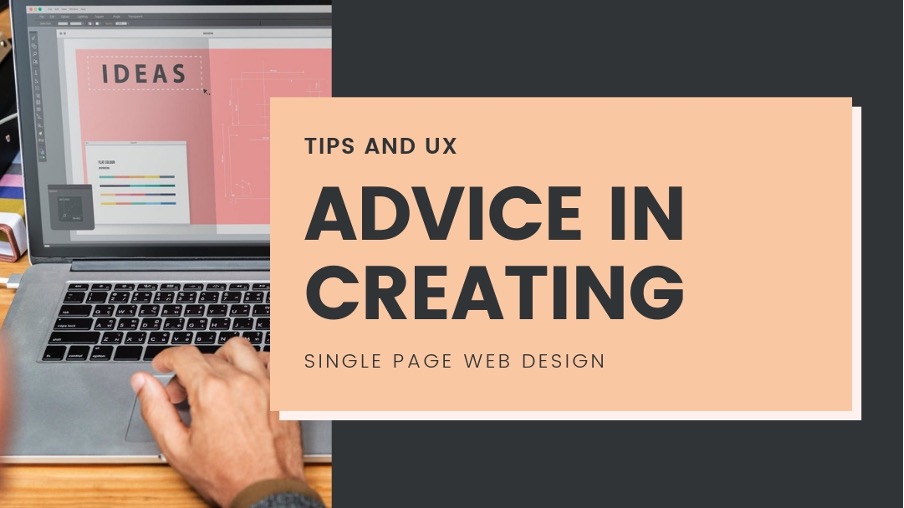
So, you are planning on going for a single page web design, that’s great! This approach may have a few limitations, but it’s quite useful for several purposes. In essence, these websites are used as some presentations for an artist, an entrepreneur, a product, or a company.
It’s not very uncommon to find portfolio pages, product sites, business websites or business offerings in just one page. But before we go over some Adelaide web design tips on how to improve the design of a single page site, let’s check some of the drawbacks and advantages of this.
Advantages and disadvantages of single-page design

Pros
When it comes to single-page designs, the most obvious benefit is that it is simple to maintain, design, and update. Also, the site’s mobile design will be easy since it’s perfectly adaptable for a mobile device.
The design of your website will depend on its purpose. But it can be convenient and very simple to use, too. If you have a message behind your website and uniformity, then having a single-page website is still the best to go.
For presenting a single product or a single idea, a single page design provides the chance to organize information in such a way that it’s handy for you and the users. Aside from that, you can arrange information in the form where visitors can discover things in a particular order you want them to.
Furthermore, if you want to present your project or company to your audience, a single page design will do. And lastly, the best advantage for a single page design is that it can increase conversions. When you put your conversion funnel on one page, the conversion process is quick and straightforward.
Cons
As much as single-product presentations are great for single-page designs, it won’t go well when you want to show several services or products. If you put all of these on one page, everything will look confusing and messy.
On this note, scalability is also an issue. If you want to expand your offers and your business, you might have to add a few more pages. In this case, your site is no longer a single page.
Often, people like cramming a lot of information on a single page and end up placing a lot of links on the site. This is not the best way to do it since you’re violating a concept and complicating an idea.
Especially if people don’t like ending up on a different website, you should always keep simplicity in mind when it comes to single page sites.
Aside from this, by having all content in one URL, you are creating a lot of issues. One example is that it is harder for your visitors to share a part of your content that they like. But it is also harder to analyze which of your content is performing the best.
Lastly, you will get into trouble with SEO. If you have a lot of content on your website, chances are it will have a hard time loading. Your site speed is going to decrease. You might ruin your rankings. With a lot of keywords stuffed in it, you will have a hard time optimizing your website. There is a limitation to this number.
All in all, if you are going for this design, you need to have a logical connection between the ideas and products that you are going to present. Here are some tips on how to make your single page site user-friendly and more appealing.
Tips

Divide your page into several sections
With only one page to work with, you might have a hard time finding your way around it. One way to make it better is by breaking it up into distinct segments. Or else, the visitors will feel a bit overwhelmed by the time they check out your site.
There are several techniques you can do to divide your page. Use different fonts, colors, and styles. You can also separate them with a blank space or a heading. Nevertheless, a simple blank space will do. You might have to put proper navigation too. Avoid confusing your audience, and your audience may have a hard time distinguishing the different sections.
On the other hand, you can try playing with the divisions and being creative which can result in excellent web design. Plus, when you work with an excellent graphic services provider, it’ll work wonders for your site!
You should order the sections continuously and logically. This includes the content. If you have a business page, you may want to add the different sections that multi-page businesses have – only put in an organized and well-divided page.
Easy navigation
Make a clear separation between your sections to help solve navigation issues. You have the choice to merely scroll, but this might give your users a hard time to keep up. A lot of people aren’t patient about this.
Placing a sticky navigation bar to your single page site can work wonders. Plus, it’s best to let your readers know what section they are reading.
Check the hierarchy
When dealing with UX, you can direct your users to focus on the elements that you think are the most significant. Organize your content to make it informative, easy to scan, and provide a high flow when reading.
All in all, a single page design is excellent, but you do need to be careful. Develop your site and serve a single, uniform, and straightforward purpose. Or else, it will look very much inconvenient.
And the worst part? You’ll cause a lot of trouble in terms of functionality, content, and looks. So think twice or thrice before you choose a single page design. Ensure you follow the above tips to make the best site there is.
Interesting Related Article: “What is responsive web design (and how does it work)?“

